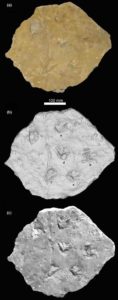
A new paper has revealed an ancient trackway, found imprinted on a block of sandstone from the base of Hardraw Force Waterfall in Wensleydale, North Yorkshire, is the oldest record of amphibian tracks in the UK dating back 340 million years.
The trace fossil, currently on display at the Natural History Museum, was 3-D scanned in order to visualise it in further detail as part of a research project by a previous undergraduate student from the University of Birmingham, Hannah Bird. The tracks belong to the earliest relatives of modern amphibians called temnospondyls, specifically the edopoids, or “glutton-faced animals.”
Hannah Bird elaborated: “We used scanning and photography to make a 3-D digital model, allowing us to better visualise and identify the footprints and invertebrate traces. Determining whether individual prints were made by hands or feet, as well as the direction of movement, certainly proved troublesome at times but we were finally able to reconstruct how this amphibian might have moved in life.”
Edopoids were crocodile-like animals, at least two metres in length. It was revealed that the edopoid walked across the sandy bed of river delta along with contemporary invertebrate animals including arthropods, worms and molluscs.
The study has presented a rare insight into the early Carboniferous period and tetrapod diversification in the United Kingdom as well as how temnospondyls spread across Euramerica.
Scientific Associate of the Natural History Museum Angela Milner said: “Although this specimen has been in the Natural History Museum’s collection for a long time, modern 3-D scanning techniques have revealed a wealth of detail that was almost impossible to see on the original tracks.”
Abstract
The ichnological fossil record has previously provided key evidence for the diversification of land vertebrates (tetrapods) during the Carboniferous Period, following the invasion of the land. Within the UK, tetrapod ichnofossils from the late Carboniferous of the English Midlands are well documented, but few such fossils are known from earlier in the period. We present a rare ichnological insight into early Carboniferous tetrapod diversification in the United Kingdom based on a Visean-aged specimen collected from an interdistributary trough palaeoenvironment at Hardraw Scar, Wensleydale, North Yorkshire. This specimen represents the stratigraphically oldest known tetrapod trackway from the UK. We refer this specimen to Palaeosauropus sp., providing the earliest known occurrence of an edopoid temnospondyl. Supplementing the sparse record of contemporary body fossils from the early Carboniferous, this provides further insights into the diversification of temnospondyl amphibians across Euramerica.
Refrence:
Hannah C. Bird et al. A lower Carboniferous (Visean) tetrapod trackway represents the earliest record of an edopoid amphibian from the UK, Journal of the Geological Society (2019). DOI: 10.1144/jgs2019-149
Note: The above post is reprinted from materials provided by The Geological Society.










